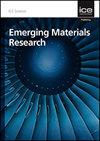采用响应面方法和可取性方法对 12 级钛的线切割加工进行参数研究
IF 1.2
4区 材料科学
Q4 MATERIALS SCIENCE, MULTIDISCIPLINARY
引用次数: 0
摘要
采用响应面法研究了不同工艺参数对12级钛合金电火花线切割加工过程中材料去除率和表面粗糙度的影响。考虑四个参数(脉冲导通时间、脉冲关断时间、送丝量和间隙电压)和每个选定变量的三个水平来进行实验工作。根据实验结果,生成MRR和sr的数学模型,并进行方差分析(ANOVA)研究,以找到显著的工艺参数。方差分析结果表明,所建立的MRR和SR模型都是显著的,并且发现脉冲开启时间是最显著的参数。此外,还采用可取性方法对响应变量的单目标和多目标标准进行了考察。发现所有情况下的可取性函数为1。材料去除率最大为12.4845 mm3/sec,表面粗糙度最小为1.4911 μm。多目标优化得到的MRR最大值为12.0942 mm3/min,表面粗糙度最小值为1.7167 μm。最后,用扫描电镜检查加工表面的表面形貌。本文章由计算机程序翻译,如有差异,请以英文原文为准。
Parametric study of WEDM on titanium grade 12 using response surface methodology and desirability approach
Present experimental study aims to scrutinize the effect of different process parameters on material removal rate (MRR) and surface roughness (SR) of titanium grade 12 alloy during wire electro discharge machining (WEDM) using response surface methodology (RSM). Four parameters (pulse on time, pulse off time, wire feed, and gap voltage) and three levels of each selected variables are considered to conduct the experimental work. Depending on experimental results, mathematical model is generated for both MRR and SR. Analysis of variance (ANOVA) study is performed to find significant process parameters. ANOVA results yield that developed models for both MRR and SR are significant and pulse-on time is found to be the most significant parameter. Additionally, help of desirability approach is also taken to scrutinize single-objective and multi-objective criterion of response variables. Desirability function for all the cases are found to be 1. Maximum material removal rate is observed as 12.4845 mm3/sec while minimum value of surface roughness is found as 1.4911 μm. For multi-objective optimization, maximum value of MRR and minimum value of surface roughness are obtained as 12.0942 mm3/min and 1.7167 μm respectively. Finally, surface morphology of machined surfaces is examined using SEM micrographs.
求助全文
通过发布文献求助,成功后即可免费获取论文全文。
去求助
来源期刊

Emerging Materials Research
MATERIALS SCIENCE, MULTIDISCIPLINARY-
CiteScore
4.50
自引率
9.10%
发文量
62
期刊介绍:
Materials Research is constantly evolving and correlations between process, structure, properties and performance which are application specific require expert understanding at the macro-, micro- and nano-scale. The ability to intelligently manipulate material properties and tailor them for desired applications is of constant interest and challenge within universities, national labs and industry.
 求助内容:
求助内容: 应助结果提醒方式:
应助结果提醒方式:


